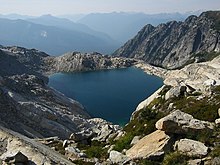Glacier Peak Wilderness
|
Glacier Peak Wilderness
|
||
|
Glacier Peak (3,213 m) |
||
| location | Chelan County / Snohomish County / Skagit County , Washington , USA | |
| surface | 2,990.75 km² | |
| WDPA ID | 368950 | |
| Geographical location | 48 ° 7 ′ N , 121 ° 7 ′ W | |
|
|
||
| Setup date | 1960 | |
| administration | US Forest Service | |
The Glacier Peak Wilderness is an almost three thousand square kilometers large wilderness area in the United States . It extends over approximately 35 miles long and 20 miles wide in the counties of Chelan , Snohomish, and Skagit in the Northern Cascade Mountains in Washington State . The area lies partly in the Wenatchee National Forest and partly in the Mount Baker National Forest and is characterized by heavily forested stretches of stream, steep-walled valleys and dramatic-looking glacier - crowned peaks. The dominant geological feature of the area is the 3,213 meter high Glacier Peak . It is the most remote volcanic peak in the Cascade Mountains with the most active glaciers in the United States outside of Alaska and Hawaii . Glacier Peak is a volcanic cone made of basalt , pumice stone and ash that erupted during periods of heavy glaciation. The closest city is Seattle .
history
The Glacier Peak Wilderness was established in 1960 through efforts by the North Cascades Conservation Council of the US Forest Service, four years before the US Congress passed the Wilderness Act .
ecology

The forest vegetation combines several species of firs , Douglas firs , hemlocks and giant arborvitae . There are also mixed stands of pine and Douglas fir on the eastern slopes. Various animal species inhabit the area, including deer , elk , black bears , mountain goats , pumas , marmots and lynxes . Smaller animals like voles are common. The last confirmed sighting of a grizzly in the US part of the Northern Cascade Mountains was in this wilderness area. The alpine lakes are good fishing waters during the ice-free months. Cutthroat trout are the preferred catch , but other species are also found.
Access
There are no roads to Glacier Peak . The usual way to get to its base is via miles of hiking trails. Typically, hikers can access the volcano from the west via the White Chuck River Valley . From the east it can be reached via the western tip of Lake Chelan or the valleys of the White River or Chiwawa River .
Hiking trails
In most years, the wilderness area is still buried under three to six meters of snow in May. Most of the trails and passes are free of snow from mid-August, but that also varies from year to year. Snow and cold rain can also occur in midsummer.
Flood damage
On October 20, 2003, after more than 250 millimeters of precipitation, there was a record flood in the wilderness area. The warm rain melted the snow and ice and washed significant amounts of water, trees and debris into the rivers. Roads, bridges and campsites were damaged and destroyed downstream. The destruction partially affected the Pacific Crest Trail (PCT). Eight bridges and a ford were destroyed along a 48 km stretch of the PCT. There was no sign that these bridges ever existed. The two most notable losses were the bridges over the upper White Chuck River and the Suiattle River . Both crossings are dangerous even under the best conditions. In addition, five main routes through which the PCT can be reached suffered damage of varying severity from “fairly light” ( North Fork Skykomish Trail ) to “severe” ( White Chuck Trail ). The Kennedy Hot Springs were buried under a mudslide and completely destroyed. Reconstruction of the road across the Suiattle River began in 2013 and should be completed in October 2014.
See also
Individual evidence
- ^ Alpine Lakes Wilderness . In: Wilderness.net . University of Montana. Retrieved April 2, 2015.
- ↑ a b c d e Glacier Peak Wilderness Area . In: Mt.Baker-Snoqualmie National Forest . US Forest Service. Archived from the original on December 7, 2005. Retrieved December 7, 2005.
- ^ Glacier Peak Wilderness . In: Okanogan-Wenatchee National Forest . US Forest Service. Retrieved April 2, 2015.
- ^ Glacier Peak Wilderness . In: Mt.Baker-Snoqualmie National Forest . US Forest Service. Retrieved April 2, 2015.
- ^ Joel Connelly: North Cascades Conservation Council . In: The Online Encyclopedia of Washington State History . HistoryLink. February 18, 2011. Retrieved April 2, 2015.
- ^ Flood Damaged Trails . In: Mt.Baker-Snoqualmie National Forest . US Forest Service. Archived from the original on December 5, 2005. Retrieved December 5, 2005.
Web links
- Glacier Peak Wilderness (Okanogan-Wenatchee National Forest) US Forest Service (English)
- Glacier Peak Wilderness (Mt.Baker-Snoqualmie National Forest) US Forest Service (English)
- Glacier Peak Wilderness Wilderness.net (The University of Montana) (English)


